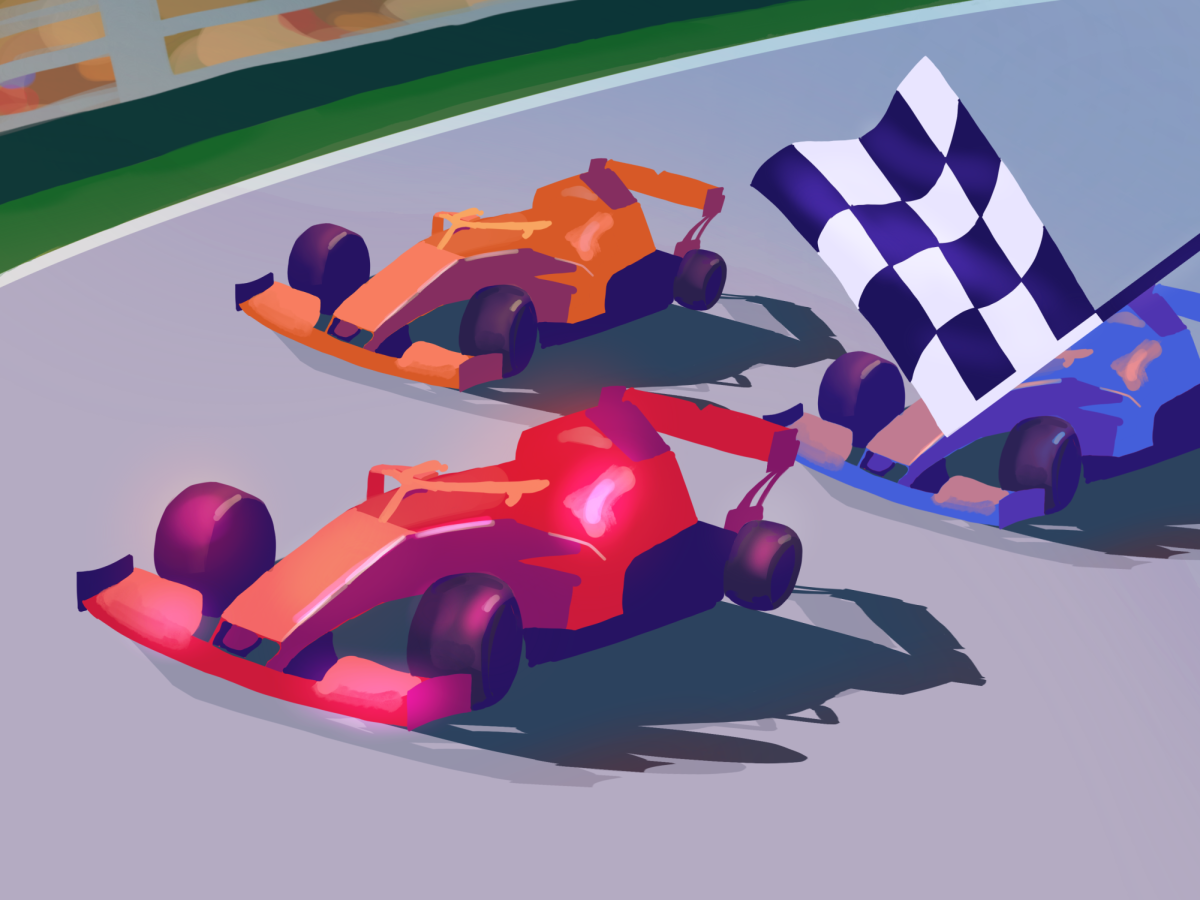After grabbing her fuzzy blanket and sinking deeper into the sofa, junior Amelia Finnis carefully balances her breakfast bowl on the coffee table, slipping slowly into sleep.
But as her brother presses play on a TV remote to begin watching a Formula 1 race while warm sunrise peeks through the curtains, her body fills with energy watching the brightly colored cars flash by in staccatos around the track.
Within 45 minutes, Finnis begins to yawn, feeling her eyes flutter as the colorful flash of different cars light up the screen. But she jolts forward quickly when her team suddenly overtakes another car and becomes a serious competitor for the race win. Finnis said the excitement and hopefulness she felt while watching suspenseful moments during the race have her and her family staring wide-eyed, hooked onto the screen in anticipation of what will happen next.
“The cars quite literally fly by you and while you, as a viewer, feel like these drivers are endlessly zooming across your screen, you don’t realize how quickly unexpected things can happen, such as crashes or overtakes,” Finnis said. “You are always held in suspense, which is why I love this sport so much.”
Though Formula 1 has traditionally been a sport where many of its fans reside in Europe, Fédération Internationale de l’Automobile, the governing body of F1, started branching the sport into America by constructing new circuits in Miami and Las Vegas within the last year. In 2023, American viewership of F1 nearly doubled from 554K in 2018 to 1.11 million, according to ESPN Press Room.
According to junior Otto Kiss Meyerfreund, both old and new fans agree that while adding new circuits increases viewership and fan base, the decision will also hurt drivers’ health, increase their fatigue and exhaustion, and carry adverse effects on the environment. With older F1 fans, many believe the expansion of circuits to the United States is unnecessary and detrimental to the sport itself.
“Many of the circuits are being placed in countries with a lot of money but no tradition, making the addition of these circuits feel added for the purpose of more publicity and viewership than for the actual sport,” Meyerfreund said. “Drivers and their teams have to travel by flying and recover within a week to compete, not to mention the effects flying and building new circuits has on the environment and carbon emissions.”
Though Finnis thinks adding new circuits would add an edge to F1, she also thinks a rotation between circuits each year would help F1 become more interesting while reducing harm to the drivers and their team’s health.
“These increased number of circuits will take the tradition out of the sport as the addition of circuits in countries who don’t have this culture makes it feel as if these circuits are added for more publicity than for the actual sport,” Meyerfreund said.
However, some fans including junior Lara Dumanli said the expansion is promising because it will make the race more interesting and relatable. Dumanli’s parents are immigrants and while she wasn’t brought up in racing culture, once she started watching the sport on TV, she felt more a part of the F1 American community while still being connected to her parents’ home.
“After F1 came to the U.S. I felt more attached and interested in it as some of the drivers were from the U.S.,” Dumanli said. “I felt when drivers can drive circuits in their own country their fan base increases which allows F1 to reach more communities and gain viewership.”
Overall, F1 is an international auto-racing event encompassing 10 official teams and two drivers per team. The teams range from big-name car companies like Mercedes and Ferrari to notable sporting companies like Red Bull.
“The ability for these teams to already have a lot of sponsors and money allows them to find the best, newest technology and create innovative racing cars which is the real reason these teams are the top three,” Meyerfreund said. “Not to mention their tradition for this event which puts them at an advantage against other teams.”
Each year, F1 holds 25 events, each hosted at a different location for a specific circuit or racetrack.
The first event of the season in Bahrain from Feb. 21 to Feb. 23 is called Testing, to allow drivers and their teams to test their new technology.
After this event, each team competes in races consisting of two events to ultimately qualify in the Grand Prix.
The Prix is 190 miles long and lasts for two hours, serving as the magnum opus of F1.
For junior Anika Nair, an F1 fan, the time it takes to complete the race can make it difficult to focus and can discourage viewers from watching even part of the race, especially when races are broadcast at often scattered, inconvenient times.
“It was always hard to wake up early and rush to be on time to watch the races,” Nair said. “They would be broadcasted at times as early as 6:25 a.m. and as late as midnight. Having to wake up so early demotivated me and I would often miss the races.”
Though it can be hard for beginners to understand, Dumanli said once someone becomes familiar with the drivers of F1, the sport becomes exhilarating to watch.
“While I love the race itself, the major reason I became so hooked on the sport is the culture and the relationship between the driver and the team,” Dumanli said.
And while unexpected crashes, overtakes during the race and the speed factor are all a part of why she loves the sport, these things don’t even scratch the surface of her love for it.
Dumanli said, “I hope they incorporate a live radio system so fans can hear what the team is saying to the driver as it would elevate the sport and make it more entertaining for the fans and make the whole experience so much more fulfilling and fun.”


